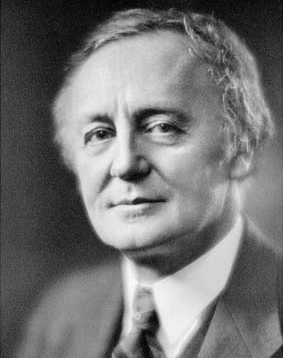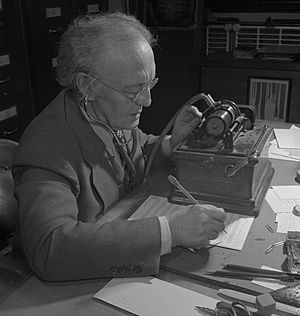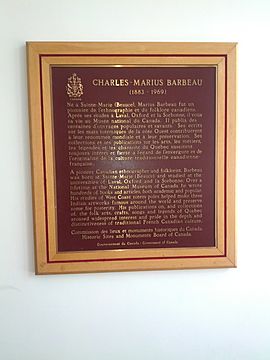Marius Barbeau facts for kids
Quick facts for kids
Charles Marius Barbeau
|
|
|---|---|
 |
|
| Born | March 5, 1883 Ste-Marie-de-Beauce (later Sainte-Marie, Quebec, Canada
|
| Died | February 27, 1969 (aged 85) Ottawa, Ontario, Canada
|
| Nationality | Canadian |
| Occupation | ethnographer, folklorist |
| Awards | Order of Canada |
Charles Marius Barbeau, CC FRSC (March 5, 1883 – February 27, 1969), also known as C. Marius Barbeau, or more commonly simply Marius Barbeau, was a Canadian ethnographer and folklorist who is today considered a founder of Canadian anthropology. A Rhodes Scholar, he is best known for an early championing of Québecois folk culture, and for his exhaustive cataloguing of the social organization, narrative and musical traditions, and plastic arts of the Tsimshianic-speaking peoples in British Columbia (Tsimshian, Gitxsan, and Nisga'a), and other Northwest Coast peoples. He developed unconventional theories about the peopling of the Americas.
Barbeau is a controversial figure as he was criticised for not accurately representing his indigenous informants. In his anthropological work among the Tsimshian and Huron-Wyandot, for instance, Barbeau was solely looking for what he defined as "authentic" stories that were without political implications. Informants were often unwilling to work with him for various reasons. It is possible that the "educated informants," whom Barbeau advised his students to avoid, did not trust him to disseminate their stories.
Contents
Life and career
Youth and education
Frédéric Charles Joseph Marius Barbeau was born March 5, 1883, in Sainte-Marie, Quebec. In 1897, he began studies for the priesthood. He did his classical studies at, Collège de Ste-Anne-de-la-Pocatière. In 1903 he changed his studies to a law degree at Université Laval, which he received in 1907. He went to England on a Rhodes Scholarship, studying at Oriel College, Oxford from 1907 to 1910, where he began his studies in the new fields of anthropology, archeology and ethnography. During the summers he would attend École des hautes études de la Sorbonne and École d'anthropologie. In Paris he would meet Marcel Mauss who would encourage him to study North American Aboriginal Folklore. He studied under R. R. Marett.
Field work

In 1911, Barbeau joined the National Museum of Canada (then part of the Geological Survey of Canada) as an anthropologist under Edward Sapir. He worked there for his entire career, retiring in 1949. (The GSC subdivided in 1920. From that period, Barbeau was with the Victoria Memorial Museum, later renamed in 1927 as the National Museum of Canada.)
At the beginning, he and Sapir were Canada's first and only two full-time anthropologists. Under those auspices, Barbeau began fieldwork in 1911–1912 with the Huron-Wyandot people around Quebec City, in southern Ontario, and on their reservation in Oklahoma of the United States, collecting mostly stories and songs.
In 1913, the German-American anthropologist Franz Boas, then affiliated with the American Folklore Society (AFS), convinced Barbeau to specialize in French-Canadian folklore. Barbeau began collecting such material the following year. In 1918, Barbeau became president of the AFS.
In 1914, Barbeau married Marie Larocque. They had a family together.
Beginning in December of that year, Barbeau carried out three months' fieldwork in Lax Kw'alaams (Port Simpson), British Columbia, the largest Tsimshian village in Canada. He collaborated with his interpreter, William Beynon, a Tsimshian hereditary chief. The anthropologist Wilson Duff (who in the late 1950s was entrusted by Barbeau with organizing the information) has called these three months "one of the most productive field seasons in the history of [North] American anthropology."
Barbeau and Beynon had a decades-long collaboration. Barbeau wrote an enormous volume of field notes—which are still mostly unpublished. Duff has characterized this as "the most complete body of information on the social organization of any Indian nation." Barbeau eventually trained Beynon in phonetic transcription, and the Tsimshian chief became an ethnological field worker in his own right. Barbeau and Beynon conducted field work in 1923–1924 with the Kitselas and Kitsumkalum Tsimshians and the Gitksan, who lived along the middle Skeena River . In 1927 and 1929, they had field seasons among the Nisga'a of the Nass River.
In 1922, Barbeau became the founding Secretary of the Canadian Historical Association. In 1929 he became a founding board member of the Royal Canadian Geographical Society.
Academic career
In 1942, Barbeau began lecturing at Laval and at the University of Ottawa. In 1945, he was made a professor at Laval. He retired in 1954 after suffering a stroke. He died February 27, 1969, in Ottawa.
Theories
Barbeau also did brief fieldwork with the Tlingit, Haida, Tahltan, Kwakwaka'wakw, and other Northwest Coast groups. He was always more focused on the Tsimshian, Gitksan, and Nisga'a. He emphasized trying to synthesize the various migration traditions of these peoples, in order to correlate them with the distribution of culture traits. He was trying to reconstruct a sequence for the peopling of the Americas. He was an early champion of the theory of migration from Siberia across the Bering Strait. This narrative is still strongly disputed by many Indigenous nations, who claim origin in North America.
His more controversial theory is that the Tsimshianic-speaking peoples, Haida, and Tlingit represented the most recent migration into the New World from Siberia. He believed that their ancestors were refugees from Genghis Khan's conquests, some as recently as a few centuries ago. In works such as the unpublished Migration Series manuscripts, the book Alaska Beckons, and numerous articles with such titles as "How Asia Used to Drip at the Spout into America" and "Buddhist Dirges on the North Pacific Coast," he eventually antagonized many of his contemporaries on this question. His thesis has been discredited by analysis of linguistic and DNA evidence.
Under Beynon's influence, Barbeau promoted the idea among western academics that the region's oral histories of migration have real historiographic value. They were long discounted because they did not conform to European traditions as accounts. Barbeau and Beynon's theory has been proven to have some merit, when taken with evidence-based data such as climate, astronomical and geological events.
He was an early proponent of recognizing totem poles as world-class high art. His opinion that they were a post-contact artistic development has been decisively disproved.
Ethnomusicology
Barbeau's primary contribution to ethnomusicology was primarily around collection. He was interested in music from a young age receiving musical education from his mother. Through his career, he would be concerned with music's influence on Anthropology. He would be named one of the first Canadian Ethnomusicologists
Barbeau was concerned with having all Canadian experience folk music. He often used trained Canadian musicians as folk music performers to bring the music to a wider audience. He received minor criticism for utilizing an American singer, Loraine Wyman.
In 1915, Barbeau would initiate the Museum collection of French-Canadian songs. Later in 1916, he set off on a recording expedition along the St. Lawrence river. His objective was to record every French Canadian folk song. He returned with notation for over 500 songs and some folk legends.
Recognition and legacy
Cultural legacy
Barbeau was a prolific writer, producing both scholarly articles and monographs, and books that presented Québecois and First Nations oral traditions for a mass audience. Examples include The Downfall of Temlaham, which weaves ancient Gitksan oral traditions with contemporary contact history. His The Golden Phoenix and other collections for children present French-Canadian folk and fairy tales.
From his fieldwork and writings on all aspects of French-Canadian creative expression, numerous popular and scholarly publications were produced. His work is credited with contributing significantly to the rise of Québecois nationalism in the late 20th century.
Awards and honours
In 1950 Barbeau won the Royal Society of Canada's Lorne Pierce Medal. In 1967 he was made a Companion of the Order of Canada. In 1969, Barbeau Peak, the highest mountain in Nunavut, was named after him.
In 2005, Marius Barbeau's broadcasts and ethnological recordings were honoured as a MasterWork by the Audio-Visual Preservation Trust of Canada. His extensive personal papers are housed in the former National Museum of Man, since 2013 known as the Canadian Museum of History.
In 1985 the Folklore Studies Association of Canada established the Marius Barbeau Medal to recognize persons making remarkable contributions to Canadian folklore and ethnology.
Portrait
An authorized bronze portrait bust of Barbeau was created by Russian-Canadian artist Eugenia Berlin; it is installed in the collection of the National Gallery of Canada.
Selected works
- (1915) "Classification of Iroquoian radicals with subjective pronominal prefixes." Ottawa: Geological Survey of Canada. Memoir no. 46. GEOSCAN.
- (1915) Huron and Wyandot Mythology, with Appendix Containing Earlier Published Records. Ottawa: Geological Survey of Canada. Memoir no. 80. GEOSCAN.
- (1923) Indian Days in the Canadian Rockies. Illustrated by W. Langdon Kihn. Toronto: Macmillan.
- (with Edward Sapir) (1925) Folksongs of French Canada. New Haven: Yale University Press.
- (1928) The Downfall of Temlaham. Toronto: Macmillan.
- (1929) "Totem Poles of the Gitksan, Upper Skeena River, British Columbia." Ottawa: National Museum of Canada. Bulletin no. 61. GEOSCAN.
- (1933) "How Asia Used to Drip at the Spout into America," Washington Historical Quarterly, vol. 24, pp. 163–173.
- (1934) Au Coeur de Québec. Montréal: Zodiaque.
- (1934) Cornelius Krieghoff: Pioneer Painter of North America. Toronto: Macmillan.
- (1934) La merveilleuse aventure de Jacques Cartier. Montréal: A. Levesque.
- (1935) "Folk-songs of Old Quebec." Ottawa: National Museum of Canada. Bulletin no. 75. GEOSCAN.
- (1935) Grand'mère raconte. Montréal: Beauchemin.
- (1935) Il était une fois. Montréal: Beauchemin.
- (1936) The Kingdom Saguenay. Toronto: Macmillan.
- (1936) Québec, ou survit l'ancienne France (Quebec: Where Ancient France Lingers.) Québec City: Garneau.
- (with Marguerite and Raoul d'Harcourt) (1937) Romanceros du Canada. Montréal: Beauchemin.
- (1942) Maîtres artisans de chez-nous. Montréal: Zodiaque.
- (1942) Les Rêves des chasseurs. Montréal: Beauchemin.
- (with Grace Melvin) (1943) The Indian Speaks. Toronto: Macmillan.
- (with Rina Lasnier) (1944) Madones canadiennes. Montréal: Beauchemin.
- (1944) Mountain Cloud. Toronto: Macmillan.
- (1944–1946) Saintes artisanes. 2 vols. Montréal: Fides.
- (1945) "The Aleutian Route of Migration into America." Geographical Review, vol. 35, no. 3, pp. 424–443.
- (1945) "Bear Mother." Journal of American Folklore, vol. 59, no. 231, pp. 1–12.
- (1945) Ceinture flechée. Montréal: Paysana.
- (1946) Alouette! Montréal: Lumen.
- (1947) Alaska Beckons. Toronto: Macmillan.
- (1947) L'Arbre des rèves (The Tree of Dreams). Montréal: Thérrien.
- (1950; reissued 1990) Totem Poles. 2 vols. (Anthropology Series 30, National Museum of Canada Bulletin 119.) Ottawa: National Museum of Canada. Reprinted, Canadian Museum of Civilization, Hull, Quebec, 1990. Individual chapters available in pdf on the website of the Canadian Museum of History.
- (1952) "The Old-World Dragon in America." In Indian Tribes of Aboriginal America: Selected Papers of the XXIXth International Congress of Americanists, ed. by Sol Tax, pp. 115–122. Chicago: University of Chicago Press.
- (1953) Haida Myths. Ottawa: National Museum of Canada.
- (1954) "'Totemic Atmosphere' on the North Pacific Coast." Journal of American Folklore, vol. 67, pp. 103-122.
- (1957) Haida Carvers in Argillite. Ottawa: National Museum of Canada.
- (1957) J'ai vu Québec. Québec City: Garneau.
- (1957) My Life in Recording: Canadian-Indian Folklore. Folkways Records
- (ed.) (1958) The Golden Phoenix and Other Fairy Tales from Quebec. Retold by Michael Hornyansky. Toronto: Oxford University Press.
- (1958) Medicine-Men on the North Pacific Coast. Ottawa: National Museum of Canada.
- (1958) Pathfinders in the North Pacific. Toronto: Ryerson.
- (et al.) (1958) Roundelays: Dansons à la Ronde. Ottawa: National Museum of Canada.
- (1960) Indian Days on the Western Prairies. Ottawa: National Museum of Canada.
- (1960) "Huron-Wyandot Traditional Narratives: In Translations and Native Texts." National Museum of Canada Bulletin 165, Anthropological Series 47.
- (1961) Tsimsyan Myths. (Anthropological Series 51, National Museum of Canada Bulletin 174.) Ottawa: Department of Northern Affairs and National Resources.
- (1962) Jongleur Songs of Old Quebec. Rutgers University Press.
- (1965–1966) Indiens d'Amérique. 3 vols. Montréal: Beauchemin.
- (1968) Louis Jobin, statuaire. Montréal: Beauchemin.
- (1973) "Totem Poles of the Gitksan, Upper Skeena River, British Columbia." Ottawa: National Museum of Canada. Bulletin no. 61, (ed. Facsimile).


